10 Things to Know about Mark Rothko

Mystic reverie, religious contemplation, meditative ecstasy, color intoxication, atmospheric levitation, enigmatic bliss… It’s difficult to find a word, a concept or an idea to describe the works of Mark Rothko. They impose themselves, they are contemplated passively and they absorb us completely. The spectator is struck by the large fields of color, their gaze is bewitched without the mind being able to understand or clearly identify the visual emotion aroused…
Here are 10 facts about this iconic 20th century artist from Artsper.
#1 Mark Rothko was born Marcus Rothkowitz
Fears about growing Nazi influence in the United States led him to adopt the Anglicized name of Mark Rothko in January 1940.
#2 Hans Hofmann was Mark Rothko’s teacher
For Hofmann, the opulence of the color and the surface were signs of a hedonistic personality.
#3 He was a children teacher
From ages 28 to 49, Mark Rothko was a children’s drawing teacher at the Brooklyn Jewish Center.

#4 Mark Rothko was a famous practitioner of Color Field painting
Clement Greenberg was the first to identify the trend of Color Field painting, which literally means: “the painting of fields of color.” However, Mark Rothko rejected any label that he judged “alienating.” For him, color was just a tool in a larger creation.
#5 The artistic recognition of Mark Rothko is indirectly due to the CIA
This information was confirmed in an article published on October 22, 1995 by two former CIA agents. Because of the absence of human figures in abstract expressionism, the works avoided the question of class warfare, the CIA wanted to finance a program aimed at the recognition and media coverage of this artistic movement. Tom Braden, a former executive secretary of MoMa and an ex-CIA agent declared: “I think that it was the most important division that the CIA had and I think that that it played a decisive role in the Cold War.”
Although it’s very likely that the artists didn’t know about this financing, the British historian Frances Stonor Saunders suggests that abstract expressionism would not have been recognized and celebrated as much as it was without the help of the CIA.
#6 In May 2012, Orange, Red, Yellow (1961) was sold at auction at close to $87 million

#7 Mark Rothko hated the idea that spectators could be disturbed by works other than his own
“It would be good if little place could be set up all over the country, like a little chapel where the traveller, or wanderer, could come for an hour to meditate on a single painting hung in a small room, and by itself.” (Mark Rothko)

#8 Rothko considered himself a “mythmaker”
A voracious reader of philosophy and classical works, his art showed a taste for mythic tragedy, or even the mystical. According to him, “the exhilarated tragic experience is for me the only source of art”.
#9 He consciously displaced the center of interest: the act of seeing, no longer the act of understanding
According to Rosenblum, in 1961 Mark Rothko succeeded in denying personal individuation thanks to this self-effacement, consequently making his work even more “sublime“!
#10 An aneurysm preventing him from painting large-format paintings led him to kill himself in 1970 in New York
To the question “Why did he kill himself?” one of his friends, John Hurt Fischer, responded, “I’ve heard different explanations: he was in bad health, he hadn’t produced anything in six months, he felt rejected by an art world whose fickle tastes had turned to younger, inferior painters. Maybe it was a little of all of those things, I don’t know. But my intuition is that his longstanding anger was one of the causes. Because it was the justified anger of a man who knew he was predestined to paint temples, and who saw that his canvases were seen only as just mundane commercial goods.”
Source: artsper





